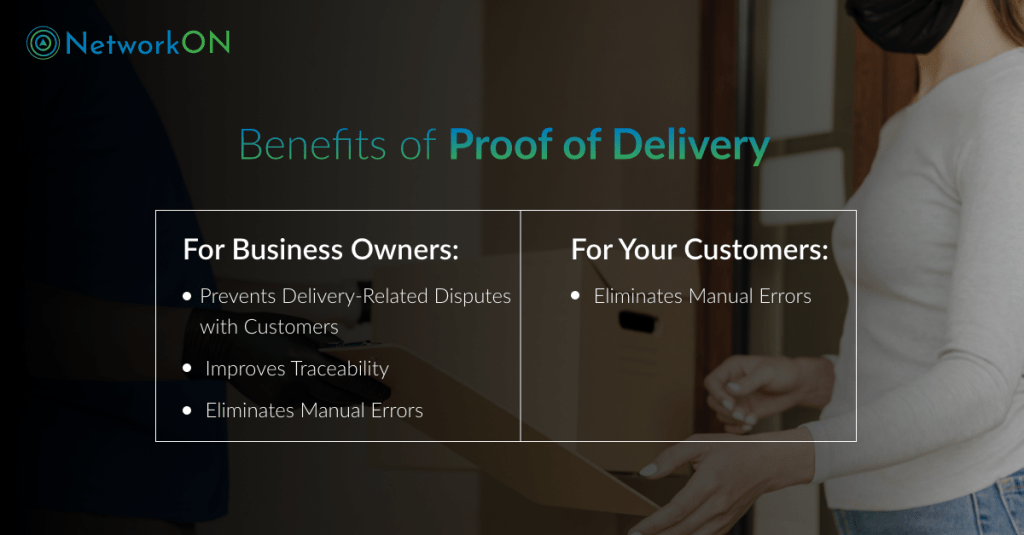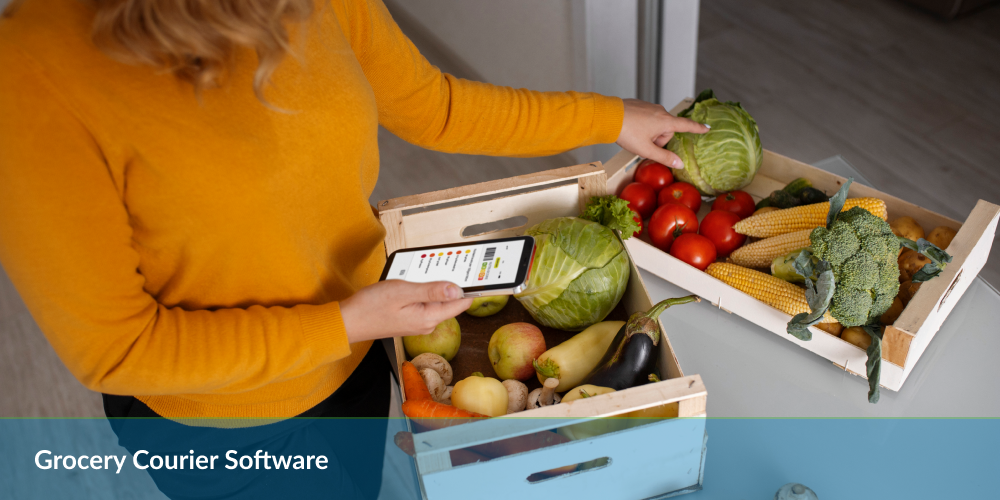Table of Contents
Proof of delivery is an extension to offer a seamless delivery experience to the customers. The last-mile leg is considered the anchor of the complete fulfillment cycle. Therefore, brands concerned with optimizing their supply chain with streamlined final-mile operations are happily embracing proof of delivery as an integral part of their operations.
Before we move ahead in the discussion, here is all we need to know about proof of delivery and why it is ideal to opt for it.
What is Proof of Delivery?
It is one of the essential features in the fulfillment cycle where a mutual acknowledgment is established between the delivery agent and the customer. In addition, the digital proof of delivery helps in marking the successful delivery of the item/ goods to the right end customer.
It increases transparency by letting the ops manager know about the delivery’s status and helps the delivery agent to own a documented approval from the customers post-delivery.
Now let us learn how electronic/digital proof of delivery is a strong pillar in making every delivery process smooth and hassle-free.
Proof of Delivery Vs. Bill of Lading
A bill of lading is a written receipt from a carrier that consists of detailed information about the items shipped and delivered to the customers. On the other hand, proof of delivery is a receipt signed by the customers once they receive the materials.
Certain characteristic features of the two distinguish each other.
A bill of lading is signed when a material is picked up from a specific location. It is a written confirmation about the item carefully picked by the carrier.
However, proof of delivery is a document that the customer signs once the material is received at their location.
Both the documents are critical documents that act as a mutual confirmation about the item being received and delivered as expected. Therefore, both have their roles and should not be overlapped.
What is Electronic Proof of Delivery (ePod)?
Electronic proof of delivery is a digital method that helps businesses to send delivery receipts to their customers. Ditching to age-old traditional paperwork, the ePod is known to be executed using smart electronic proof of delivery software or proof of delivery app.
It increases order accuracy in the order fulfillment cycle. It also plays a crucial role in passing the required and real-time information to all the involved logistics stakeholders.
When packages are shipped, they pass through various activities. Any breach in any of the activities or in-between processes can result in unwanted or unplanned delays. The associated potential risks of damage, errors, and money wastage become cyclical.

And, if there is a lack of proper proof of delivery tracking, the whole delivery process turns out to be overwhelming for all the logistic stakeholders. And no one wants their logistic operations to undergo these complexities. That is why proof of delivery has come into the picture. The essence of proper documentation is now known to all and is well appreciated.
In addition, electronic proof of delivery resolves any unexpected conflicts between customer- driver, customer-admin, and driver-admin. It helps in maximizing the agents’ operational efficiency and allows more in-ground visibility of logistic operations to all the involved stakeholders.
Challenges in Traditional Proof of Delivery
Traditional options of keeping a tab over the logistic delivery operations are becoming stagnant. One can easily claim a delivery completion, but is that enough in today’s time?
Here are a few of the common challenges associated with the traditional proof of the delivery system.
1. Interrupted Visibility of Operations
There is a lack of traceability of the items in traditional methods during the whole fulfillment cycle. If any of the stakeholders wish to know the order-level status in the supply chain, it is next to impossible.
Though there might be certain visibility of operations such as picking up of order, the rider on a job, or being delivered, there are still some blind spots where the stakeholders get clueless.
Any logistic business knows how important it is to achieve a better delivery ( it brings out a high customer satisfaction rate and lesser operational cost). Therefore, the traditional ways might ditch the on-go visibility of the operations in progress.
2. Communication Gap Between the Stakeholders
Any update or change in the delivery status needs to be notified to the involved stakeholders in the delivery process. However, it might not be possible in traditional ways of getting proof of delivery.
For instance, if there is any change in delivery time ( asked by customer), if the driver is not notified on time, there are high chances of failed attempts. This can be a cost-alluring factor that can put all your operations at stake.
3. Unreported or Delayed Reporting of Incidents
The supply chain is growing with more complexities. Any incident from the driver’s side can impact the whole delivery task planned for the day. It can make it challenging for the decision-makers to plan proactively. In some of the cases, the incidents remain unnotified too.
One unplanned event can create a vicious cyclical challenge in optimizing your supply chain. On the other hand, losing the customer’s trust also gets amplified. And in today’s time, you can not afford to lose your potential and loyal customers.
4. Tough Time in Managing Paperwork and Record-Keeping Documents
Last but not least, when a logistic business goes by the traditional ways of keeping records, it requires more time to manage and maintain the paperwork. This whole process is time-consuming and has a high potential of risks too.
The probability of manual errors also doubles with this kind of work. Suppose you are looking for better compliance in your logistic operations. In that case, shift to electronic proof of delivery tracking to increase efficiency and productivity.
Benefits of Proof of Delivery
The proof of delivery is curated so that it offers a win-win situation to all the involved stakeholders. You can ensure safer delivery of items and make your customers happy at the same time. Here is all you can get by choosing electronic proof of delivery.

For Business Owners:
- Prevents Delivery-Related Disputes with Customers:
Electronic proof of delivery prevents frictions or disputes between the customer and the business. In addition, it protects vendors from disputable circumstances. In case of any conflict or misalignment, digital proof can solve the conflict.
- Improves Traceability
Electronic proof of delivery system helps in adding transparency to your logistics operations. It plays a crucial role in removing the blind spots and enhancing the traceability of the items out for delivery with real-time updates. Moreover, in case of any unexpected event, the business can take proactive actions too. Hence, it helps in offering real-time insights too. .
- Eliminates Manual Errors
Paper-based proof of delivery can easily get tampered. The potential risk of losing the documents also remains on the higher side. If you choose to go with ePod, it expedites the delivery process.
For Your Customers:
- Offers Safe Delivery of Documents
Suppose your customer sends important documents from one place to another. In such cases, getting proof of delivery becomes essential and non-negotiable. Your customers can easily rely on your delivery services with electronic proof of delivery of receiving the document. It is a twin advantage for both; the sender and the receiver. Hence, customers now demand to own a proof of delivery document once the delivery is completed.
Types of Electronic Proof of Delivery
Your agents can collect the following types of proof of delivery based on your business needs.
1. QR code Scanning
It is one of the easiest and most common ePod preferred by delivery agents. The QR codes help initiate contactless delivery and offer a quick collection of information (real-time) as soon as the delivery is completed.
2. Digital Signature
It is also one of the popular methods. Customers can sign on to the app when they receive the package.
3. Digital Photos
Collecting digital photos is a conventional type of electronic proof of delivery.
4. OTP Verification
It is one of the standard processes of electronic proof of delivery in which the customer receives an OTP to verify his identity to get the shipment.
How can you provide Proof of delivery with NetworkON?
Proof of delivery is an integral feature of the NetworkON agent app. Based on your business needs, you can choose the type of proof of delivery. NetworkON improves delivery teams’ efficiency with its robust and user-friendly platform.
You can also check the top features of our agent app here.
Wrapping Up
To summarize, electronic proof of delivery
- Prevents delivery-related disputes with customers
- Improves traceability
- Eliminates manual errors
- Increases transparency
Connect with our product experts to know how NetworkON connects, automates and orchestrates delivery operations.





0 Conversations